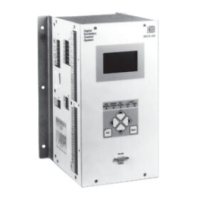DECS-200 Modbus™ Communication 7-1
SECTION 7 • MODBUS™ COMMUNICATION
INTRODUCTION
This section describes the Modbus™ communication protocol employed by the DECS-200 and how to
exchange information with the DECS-200 over a Modbus™ network. The DECS-200 communicates by
emulating a subset of the Modicon
TM
984 Programmable Controller.
DECS-200 MODBUS PROTOCOL
Modbus communications use a master-slave technique in which only the master can initiate a transaction
called a query. When appropriate, a slave (DECS-200 ) responds to the query. When a Modbus master
communicates with a slave, information is provided or requested by the master.
Information residing in the DECS-200 is grouped characteristically in categories. The following information
categories are maintained by the DECS-200:
C1 - Product Information Registers
C2 - Metering Registers
C3 - Reporting Registers
C4 - Control System Configuration Parameters Registers Group 1
C5 - Operating Mode Parameter Registers
C6 - Setpoints Parameter Registers
C7 - Startup Parameter Registers
C8 - Limiter Parameter Registers
C9 - Gains Registers
C10 - Protective Functions Parameter Registers
C11 - Calibration Parameter Registers
C12 - Relay Parameter Registers
C13 - Communications Parameter Registers
C14 - Front Panel Metering Configuration Registers
C15 - Control System Configuration Parameters Registers Group 2
All supported data can be read or written as specified in the register table. Abbreviations are used in the
register table to indicate the register access type. Register access types are read/write (RW) and read
only (R -).
All categories except Product Information (C1), Metering (C2), Reporting (C3) and Calibration (C11) can
generally be written via a Modbus message as well as read. Categories C1 and C2 are strictly read-only.
(Categories C3 and C11 are currently not supported and therefore cannot be read or written.)
When a slave receives a query, the slave responds by either supplying the requested data to the master
or performing the requested action. A slave device never initiates communications on the Modbus
network and will always generate a response to the query unless certain error conditions occur. The
DECS-200 is designed to communicate on the Modbus network only as a slave device.
A master can only query slaves individually. If a query requests actions unable to be performed by the
slave, the slave response message contains an exception response code defining the error detected.
MESSAGE STRUCTURE
Master initiated queries and DECS-200 (slave) responses share the same message structure. Each
message is comprised of four message fields. They are:
• Device Address (1 byte)
• Function Code (1 byte)
• Data Block (n bytes)
• Error Check field (2 bytes)
Device Address Field
The device address field contains the unique Modbus address of the slave being queried. The addressed
slave repeats the address in the device address field of the response message. This field is one byte.

